Over 545,000kg of honey produced in Hashtroud county since last March

TEHRAN- More than 545,000 kilograms of honey has been produced in Hashtroud county, in the northwestern East Azarbaijan province, since the beginning of the current Iranian calendar year (March 21, 2022), the head of the county’s Agriculture Department announced.
Majid Ahmadi said that the mentioned amount of honey has been produced by 741 beekeepers in the country.
Referring to the census of traditional and modern beehives in Hashtroud apiaries, he said in the census, the total number of traditional and modern beehives was 52,944, of which 8,947 are traditional and 43,997 are modern.
As announced by an official with Agriculture Ministry, the honey consumption per capita in Iran is one of the highest ones in the world, because the consumption per capita in the world is about 500 grams, while in Iran it is more than one kilogram.
Hossein Damavandi-Nejad, the deputy minister for livestock products, said, “The production of 120 million tons of agricultural products in the country and standing at the eighth place in the world in this field, has the footprints of honey bees in it, and some products in gardens and farms are up to 100 percent dependent on bees and without bees they will not be able to pollinate by wind and other insects”.
“In some countries, the gardener must pay up to 100 dollars to the beekeeper for the beekeeper to establish his bee colony in the garden for a while, but in our country, in addition to the gardener taking a fee from the beekeeper for establishing the colony, with some unannounced pesticides spraying, they bring damages to beekeepers”, he lamented.
Damavandi-Nejad considered the most important service of honeybees to be related to horticulture and agriculture and restated: “Our honey consumption per capita is one of the highest ones in the world, despite the fact that the cost of honey production in our country is high, and it is a promising issue.”
Based on the data released by the United Nations Food and Agriculture Organization (FAO), Iran is the third-largest producer of honey in the world.
Last August, the director of the Agriculture Ministry’s beekeeping development program had said the country’s annual honey production is expected to reach 115,000 tons in the current Iranian calendar year 1401 (ends on March 20).
Touraj Saremi noted that Agriculture Ministry has defined a five-year development plan to reform the structure of the country's apiaries and increase the quantity and quality of honey production during the Iranian calendar year 1401 to 1405 (begins in March 2026).
“The implementation of this program requires the necessary support for providing inputs, implementing educational-training programs, and providing facilities to beekeepers. It is also required to provide apiaries with insurance coverage to reduce the risks and to ensure sustainable production,” he said.
The official noted that the ministry is also pursuing opening a credit line to be able to meet part of the needs of producers in this sector within the framework of rules and regulations.
Iranian beekeepers managed to produce 112,000 tons of honey in the previous Iranian calendar year.
Due to the high quality of Iranian honey, the product is exported to many countries including China, Bahrain, Kuwait, Qatar, Oman, Germany, the United Kingdom, Canada, Hong Kong, Australia, Indonesia, Malaysia, Iraq, and Lebanon.
Back in March 2020, the former director of the Iranian Agriculture Ministry’s beekeeping development plan had said the country's beekeeping industry was planned to become the leading agricultural sector in the country, the leading honey producer in the region, and a strong player in the world markets.
“Benefiting from up-to-date knowledge, and technology, the industry is going to provide reliable, high-quality products with greater value-added,” Farhad Moshir Qafari said.
Over the past five years, Iran’s beekeeping industry shifted its focus from producing only one main product, namely honey, to producing other bee secretions such as royal jelly and bee venom, Qafari said at the time.
“Melittin is a very valuable bee venom extract that is currently imported, but the beekeeping industry has the potential to produce this substance inside,” he stressed.
MA/MA
